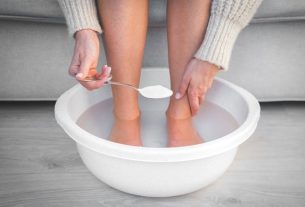Some home treatments for muscle pain, such as applying cold or hot compresses, massaging the affected muscle with essential oils or drinking herbal tea, help reduce pain, swelling and inflammation at the site or relax the muscle, improving pain. and discomfort.
Muscle pain, also known as myalgia, occurs anywhere on the body, such as the neck, back, calf or chest, and is normally caused by excessive physical activity or poor posture, which can result in muscle contractures, muscle strain or strain, or even due to health conditions, such as fibromyalgia, for example. See other causes of muscle pain.
These home treatments can help relieve muscle pain, however, when the pain is frequent or increases in intensity over time, you should consult your general practitioner or orthopedist to identify its cause and recommend the most appropriate treatment.

The main home treatments for muscle pain are:
1. Apply ice packs
The best way to relieve acute muscle pain is by using ice, which has an analgesic effect, helps reduce swelling and inflammation in the area and allows the muscles to stretch.
To apply the ice pack, you must place ice inside a thermal bag or place a bag of gel in the freezer to cool, and then wrap the bag or bag of gel in a clean, dry towel and apply it to the muscle. affected, leaving it to act for 15 to 20 minutes, 3 to 4 times a day. Learn more about when and how to properly use ice to relieve muscle pain.
2. Apply hot compresses
In the first 48 hours after the injury, it is recommended to apply an ice pack, but after that, hot compresses should be used, as it helps to relax the muscle, improving pain and discomfort.
The hot compress should be used after two or three days, as this is the time needed for the ice to reduce pain and inflammation in the muscle. This compress helps to increase blood flow in the affected area, speeds up healing and relaxes the muscles.
The hot compress can be prepared by adding hot water to a thermal bag, which must be wrapped in a clean towel and applied to the affected area for about 20 minutes, 2 to 3 times a day.
3. Apply hot salt compresses
An excellent home remedy for muscle pain is a hot salt compress, as it helps reduce pain and stimulates circulation, accelerating the muscle recovery process.
Ingredients
- 500 g of salt;
- Thick fabric sock.
Preparation mode
Heat the salt in a frying pan for approximately 4 minutes and place it in a clean, thick fabric sock, so that it becomes soft. Then, apply the compress to the sore muscle and leave it on for 30 minutes, twice a day.
4. Massage with essential oils
Regular massages with essential oils help reduce muscle pain. This is because rosemary and peppermint essential oils help to stimulate circulation, and St. John’s wort essential oil has analgesic and anti-inflammatory properties.
Ingredients
- 15 drops of rosemary essential oil;
- 5 drops of peppermint essential oil;
- 5 drops of St. John’s wort essential oil;
- 1 tablespoon of almond oil.
Preparation mode
Mix the oils in a clean, dry, dark glass bottle. Shake well and massage the muscle with a little of the mixture, every day until it improves. Find out more benefits that massage has for health.
5. Rest and stretch
After a muscle injury, it is very important to let the affected area rest to help with recovery and relieve pain and discomfort.
However, when the initial intense pain and swelling become less, you should stretch the affected area, gently moving it to avoid progressive stiffness. Stretching helps to stimulate circulation and prevent scars. See which stretching exercises are ideal for back pain.
6. Drink herbal tea
Drinking valerian, ginger, white willow, filipendula or devil’s claw tea also helps with muscle pain due to its sedative, anti-inflammatory and anti-rheumatic properties.
Additionally, white willow, known scientifically as Salix alba, is rich in salicin, which is a substance similar to the main ingredient in aspirin, which works to reduce pain and inflammation in the muscle, relieving muscle pain caused by muscle strain or strain. See other benefits of white willow.
Ingredients
- 2 tablespoons of valerian extract;
- 1 tablespoon of white willow bark extract;
- 1 dessert spoon of ginger extract.
Preparation mode:
Mix the extracts and store in a dark, clean and dry glass bottle. Take half to a teaspoon, diluted in 60 mL of warm water, about 4 times a day. See other tea options for muscle pain.
This tea should not be consumed by children, pregnant or breastfeeding women, people who are allergic to aspirin or who are using anticoagulants.
Furthermore, the use of this tea is not recommended for people with gastrointestinal problems, such as ulcers, gastritis, gastroesophageal reflux, colitis or diverticulitis.
7. Apply arnica to your skin
Arnica is a medicinal plant, from the Arnica montana species, which helps to reduce pain and treat muscle strain caused by physical activities or in the case of stiff neck, bruises and inflammations, for example, due to the lactones in its composition with anti-inflammatory action. -inflammatory and analgesic.
Arnica can be used in the form of a cream, oil, tincture or even in compresses prepared with the tea of this plant. Learn how to prepare a homemade arnica ointment.
Ingredients
- 1 teaspoon of dried arnica flowers;
- 250 mL of boiling water.
Preparation mode
Place the dried arnica flowers in boiling water and let it rest for 10 minutes. Strain, dip the compress and apply warm to the affected muscle 2 to 3 times a day.
Arnica tea should not be used on skin with open or bleeding wounds, or on the eyes, and should never be ingested, due to its toxic effects.
Furthermore, arnica should not be used by people allergic to this plant or with liver disease, children under 12 years of age, pregnant or breastfeeding women.
8. Take saffron
Muscle inflammation can be alleviated with the help of turmeric, which is a medicinal plant with a long orange root, which can be made into a powder and used as a spice in several countries, especially India.
The recommended dose is 300 mg twice a day, but you can also use turmeric powder and add it to food, such as curries, soups and dishes based on eggs, rice and vegetables. See more benefits of saffron.
9. Bath with Epsom salts
Epsom salts are rich in magnesium sulfate which is easily absorbed by the skin, facilitating blood circulation, eliminating toxins, relaxing muscles and relieving muscle pain caused by muscle strain or strain, especially in the calf.
These salts should only be used for bathing, up to 3 times a week, and should not be consumed.
Ingredients
- ½ cup of Epsom salts;
- 2 to 3 liters of warm water.
Preparation mode
Place Epsom salts in a container with 2 to 3 liters of warm water or enough water to cover your feet and reach at least mid-calf. Dilute the salts well, stirring the water with your hand, and place the leg in the water for around 15 minutes.
Another option is to place 1 cup of Epsom salts in a container with 1 liter of warm water and stir until the salts are well diluted. Then, add this solution to the bath water and stay immersed, from the neck down, for approximately 15 to 20 minutes.
Bathing with Epsom salts is contraindicated for children, pregnant or breastfeeding women, or people with kidney problems such as severe kidney failure, myasthenia gravis, muscle weakness, low amounts of calcium in the blood, or high amounts of magnesium in the blood. blood
10. Consume anti-inflammatory foods
Some foods such as turmeric, broccoli or spinach and foods rich in omega-3 such as tuna, sardines, salmon, flaxseed or chia can help reduce inflammation and, therefore, help relieve muscle pain.
These foods should be consumed daily or, in the case of fish, at least 3 to 5 times a week. Check out the complete list of anti-inflammatory foods.

Sign up for our newsletter and stay up to date with exclusive news
that can transform your routine!
Warning: Undefined array key "title" in /home/storelat/public_html/wp-content/plugins/link-whisper-premium/templates/frontend/related-posts.php on line 12
Warning: Undefined array key "title_tag" in /home/storelat/public_html/wp-content/plugins/link-whisper-premium/templates/frontend/related-posts.php on line 13




